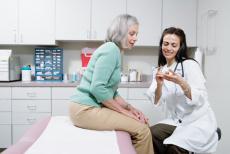Varicose veins are swollen, twisted veins that you can see just under the skin. They usually occur in the legs, but also can form in other parts of the body. Hemorrhoids are a type of varicose vein.
Your veins have one-way valves that help keep blood flowing toward your heart. If the valves are weak or damaged, blood can back up and pool in your veins. This causes the veins to swell, which can lead to varicose veins.
Varicose veins are very common. You are more at risk if you are older, a female, obese, don’t exercise or have a family history. They can also be more common in pregnancy.
Doctors often diagnose varicose veins from a physical exam. Sometimes you may need additional tests.
Exercising, losing weight, elevating your legs when resting, and not crossing them when sitting can help keep varicose veins from getting worse. Wearing loose clothing and avoiding long periods of standing can also help. If varicose veins are painful or you don’t like the way they look, your doctor may recommend procedures to remove them.
Here is a detailed overview of Varicose Veins, a common vascular condition:
Varicose Veins: Detailed Overview
1. What Are Varicose Veins?
Varicose veins are enlarged, swollen, and twisted veins that often appear blue or dark purple, usually in the legs and feet. They occur when the valves in the veins become weak or damaged, allowing blood to flow backward and pool in the veins.
2. Causes
- Valve malfunction in superficial veins
- Weak vein walls
- Increased pressure in the veins of the lower body
- Genetics — family history of varicose veins
3. Risk Factors
- Age – Vein elasticity decreases with age
- Gender – More common in women (due to hormonal factors)
- Pregnancy – Increased blood volume and pressure
- Obesity
- Prolonged standing or sitting
- Lack of exercise
- Family history
4. Symptoms
- Visible twisted, bulging veins (typically in the legs)
- Aching or heavy legs
- Burning, throbbing, muscle cramping
- Swelling in lower legs
- Worsening pain after sitting or standing for long periods
- Itching around veins
- Skin discoloration or ulcers (in severe cases)
5. Complications
Though often cosmetic, varicose veins can lead to:
- Venous ulcers
- Blood clots (superficial thrombophlebitis)
- Bleeding
- Chronic venous insufficiency
6. Diagnosis
- Physical exam
- Duplex ultrasound (to check blood flow and valve function)
7. Treatment Options
A. Conservative Measures
- Compression stockings
- Exercise and weight loss
- Elevating legs
- Avoiding prolonged standing/sitting
B. Medical Procedures
- Sclerotherapy – injection of a solution to close the vein
- Laser treatments – for smaller varicose veins
- Radiofrequency or endovenous laser ablation – heat-based methods to close veins
- Vein stripping – surgical removal of large veins
- Ambulatory phlebectomy – removal of surface veins via small skin punctures
8. Prevention
- Exercise regularly
- Avoid standing or sitting for long periods
- Elevate your legs
- Maintain a healthy weight
- Wear compression garments if at risk
